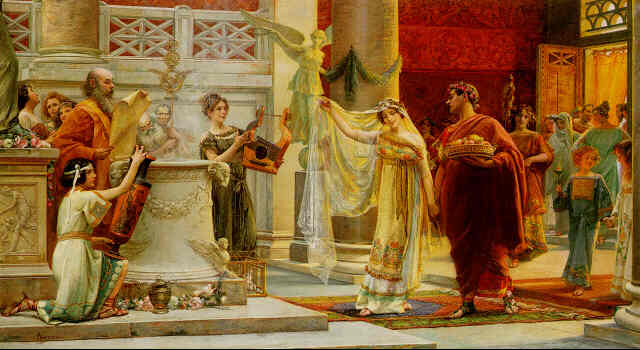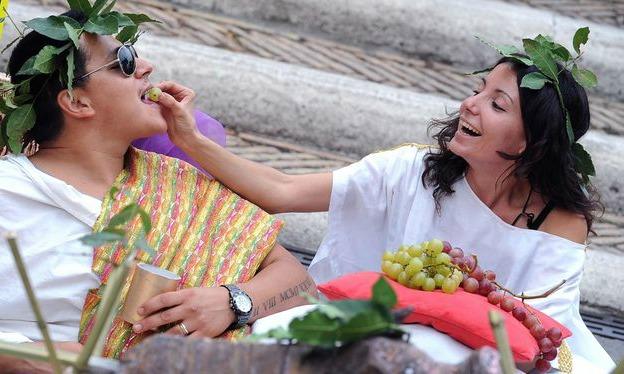What’s striking about Roman marriages is how many of the ancients’ customs have become traditions that continue to this day. Marriage for Roman citizens was a monogamous institution, a practise that became standard in Christian and Western cultures. Although couples did marry for love, marriage among the elite was regarded as a way of forging alliances to consolidate power, wealth and territory. However, marriage remained a largely private matter until Emperor Augustus introduced legislation in 18 BC. He was keen to encourage marriage, stamp out adultery and increase the Roman birth rate in Italy by encouraging childbearing. Augustus made adultery a crime and punishable by exile, and raised taxation on unmarried men and women.
 The wealthier and more important the person, the more likely it was that they would wed young, because their marriage carried greater economic and political importance than that of a plebeian. Men and women from the elite might become engaged and marry as teenagers, or sometimes they might wait years to marry. A ring, the annulus pronubis, was considered the norm where a man could afford to buy one. The prospective husband gave his fiancée a ring in a formal betrothal ceremony to mark what was regarded as the closure of a social and business contract. A man gave the ring as a warranty to his future wife, while her father or guardian made a pledge regarding the proposed marriage. The ring was usually made from iron and worn on the third finger of the left hand because the Romans believed that a vein, the vena amoris, ran straight from the finger to the heart. The bride’s family supplied a dowry in the form of clothing, slaves, furniture, jewellery or land. The dowry became the groom’s property.
The wealthier and more important the person, the more likely it was that they would wed young, because their marriage carried greater economic and political importance than that of a plebeian. Men and women from the elite might become engaged and marry as teenagers, or sometimes they might wait years to marry. A ring, the annulus pronubis, was considered the norm where a man could afford to buy one. The prospective husband gave his fiancée a ring in a formal betrothal ceremony to mark what was regarded as the closure of a social and business contract. A man gave the ring as a warranty to his future wife, while her father or guardian made a pledge regarding the proposed marriage. The ring was usually made from iron and worn on the third finger of the left hand because the Romans believed that a vein, the vena amoris, ran straight from the finger to the heart. The bride’s family supplied a dowry in the form of clothing, slaves, furniture, jewellery or land. The dowry became the groom’s property.
A wedding consisted of various rituals and a religious ceremony that varied in format over the centuries but it is likely that it included sacrificing an animal and asking for the gods’ blessing. Among rich families, on the eve of the wedding a bride would don her tunica recta, a floor-length white tunic that she would have woven herself. It also served as her wedding dress.

On the day of the wedding, a cingulum (belt) made from the fleece of a ewe was tied around the bride’s waist in an elliptically shaped Hercules knot. The belt symbolised her chastity and the groom would undo the knot in the marital bed after the couple were married. A Herculean knot was hard to untie, the undoing of the belt signified that the groom would have the virility of the god Hercules, who had had 70 children.
 Marriage signified a woman had moved from her father’s control (potestas) to that of her husband (manus). The wedding ceremony followed by a festive meal usually took place at the house of the bride’s father, which would be decorated with flowers and tapestries. The newly weds were then escorted in a procession to the groom’s house, accompanied by attendants carrying a torch of hawthorn lit from the hearth of the bride’s family. Gifts of sweetmeats, sesame-seed cakes and nuts were handed out to the guests and members of the crowd following the procession. The bride would then be carried across the threshold. The groom would offer the bride water and fire to symbolise their future life and welcome her into her new family. The bride would light the hearth at her new home using the hawthorn torch and place a coin on the family altar. The couple would later consummate the marriage in private. The following day, the groom would hold a dinner party to publicise the marriage and the festivities could continue for days.
Marriage signified a woman had moved from her father’s control (potestas) to that of her husband (manus). The wedding ceremony followed by a festive meal usually took place at the house of the bride’s father, which would be decorated with flowers and tapestries. The newly weds were then escorted in a procession to the groom’s house, accompanied by attendants carrying a torch of hawthorn lit from the hearth of the bride’s family. Gifts of sweetmeats, sesame-seed cakes and nuts were handed out to the guests and members of the crowd following the procession. The bride would then be carried across the threshold. The groom would offer the bride water and fire to symbolise their future life and welcome her into her new family. The bride would light the hearth at her new home using the hawthorn torch and place a coin on the family altar. The couple would later consummate the marriage in private. The following day, the groom would hold a dinner party to publicise the marriage and the festivities could continue for days.












